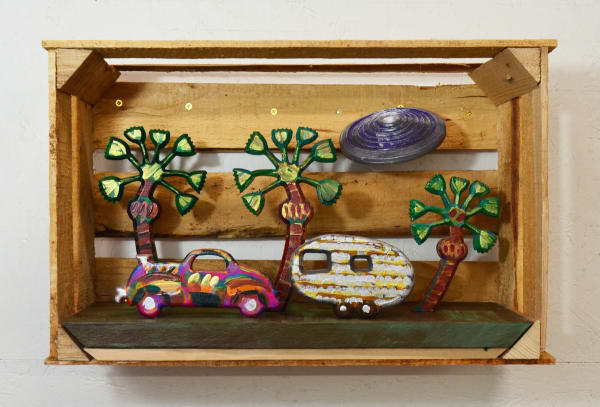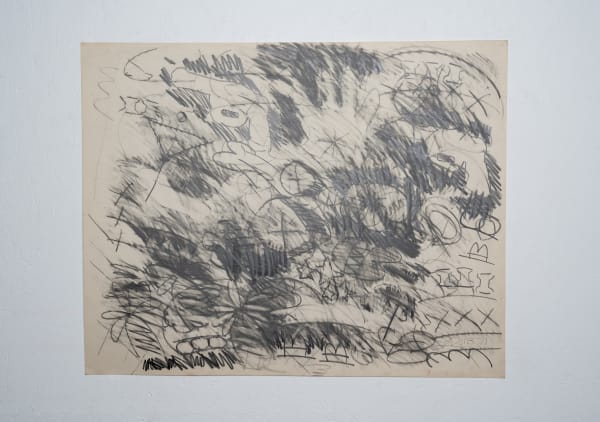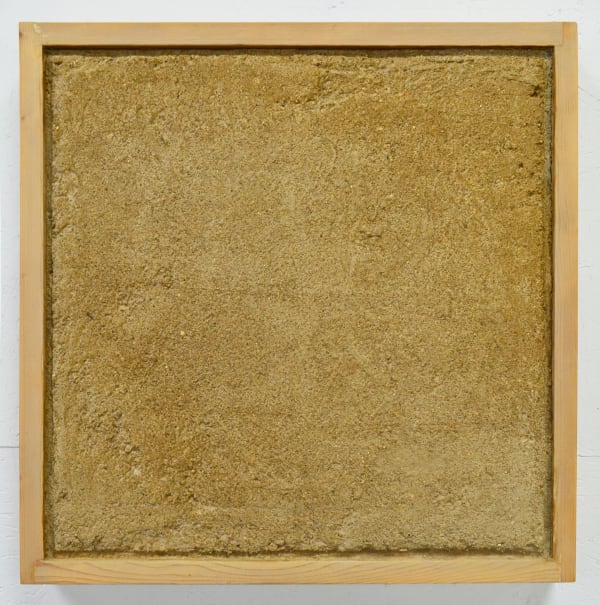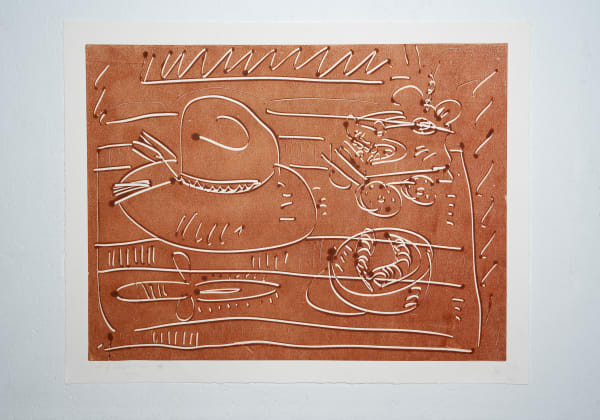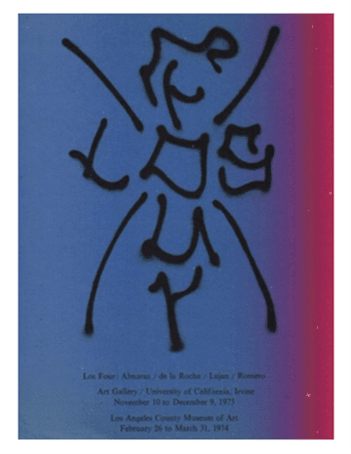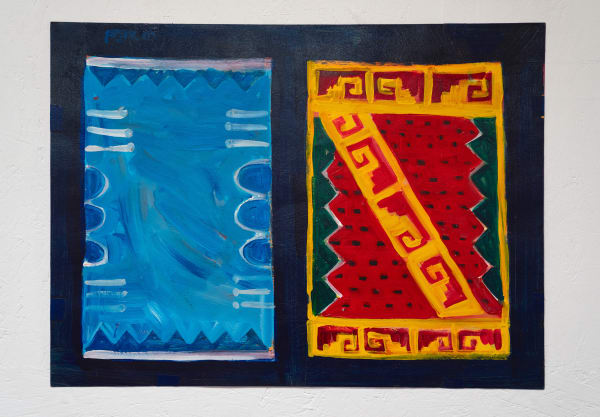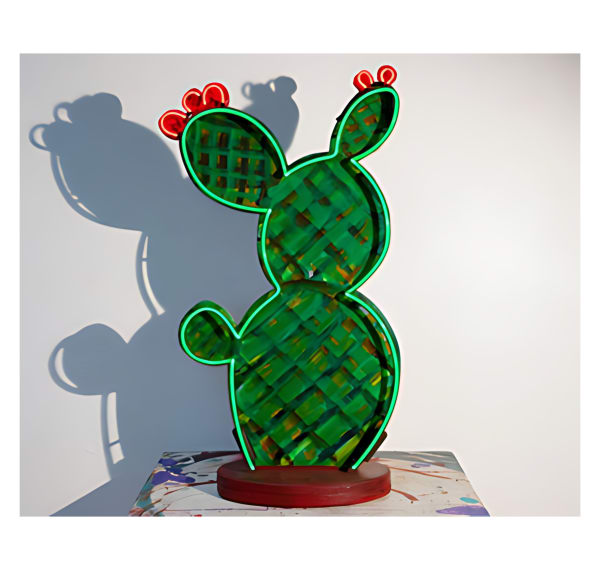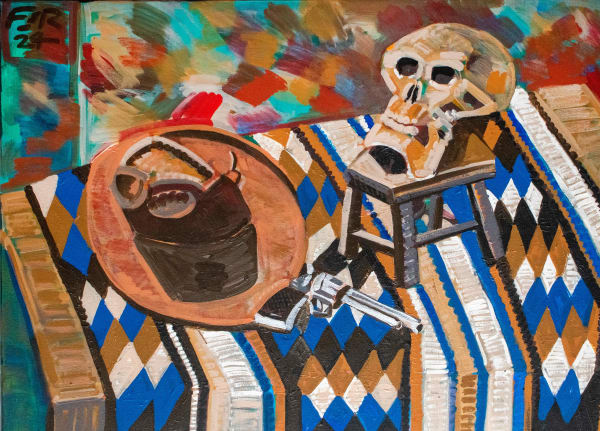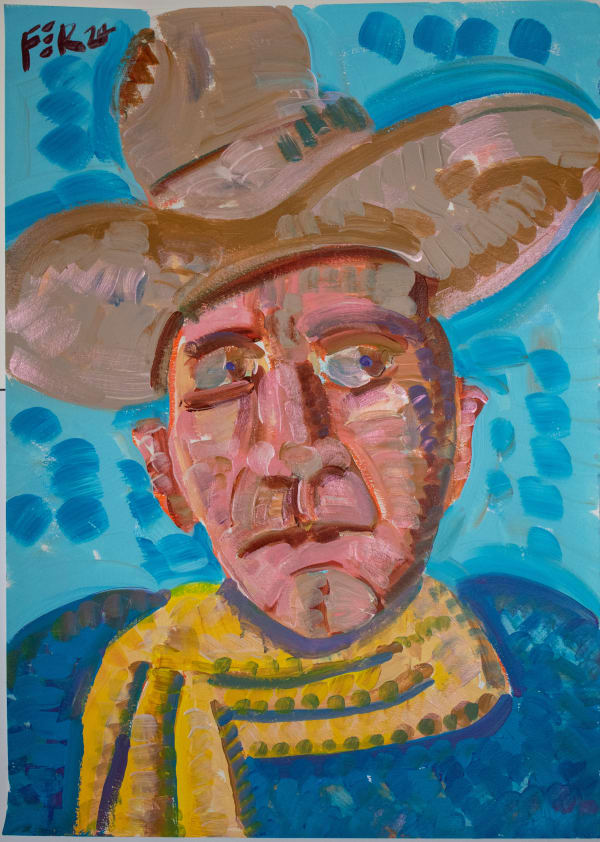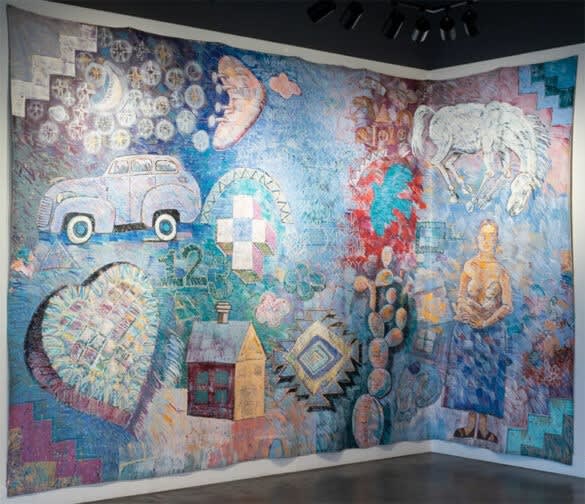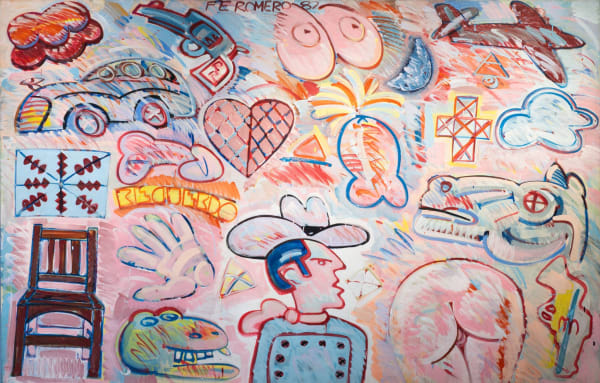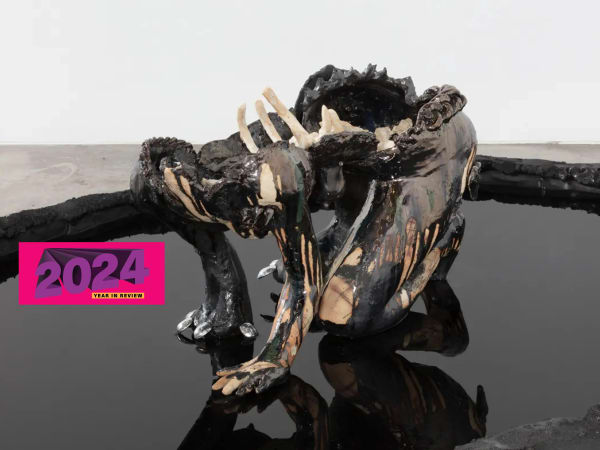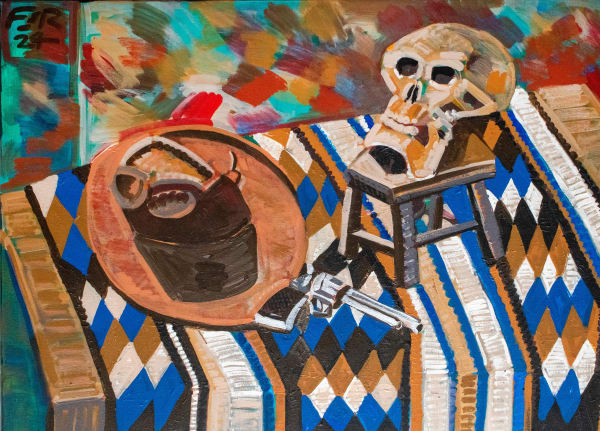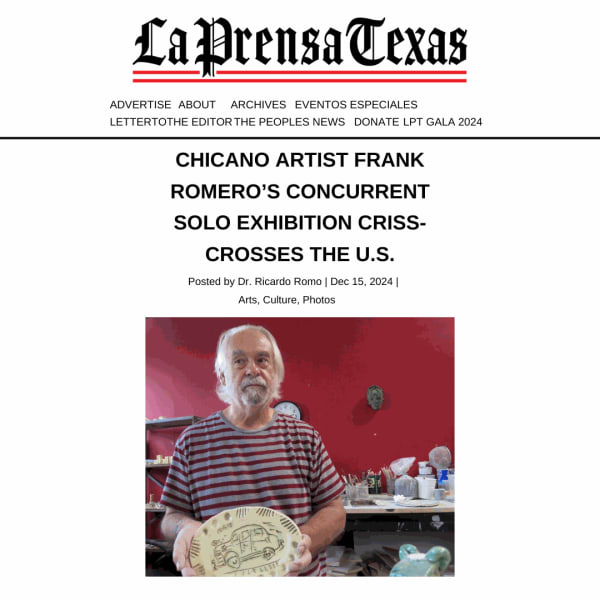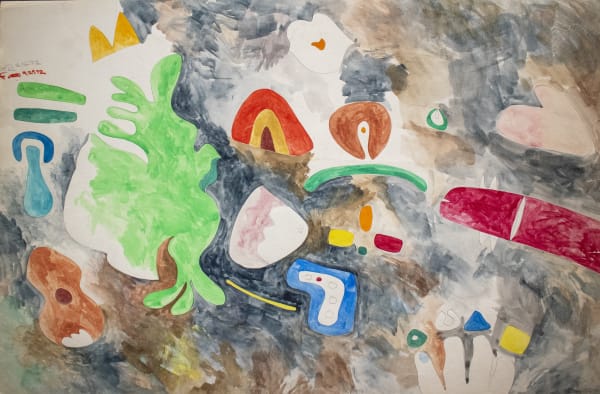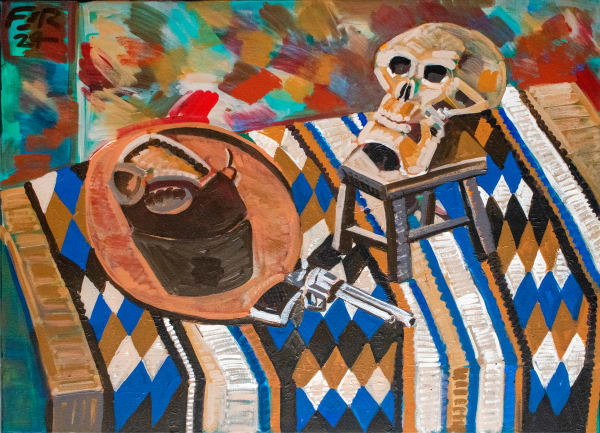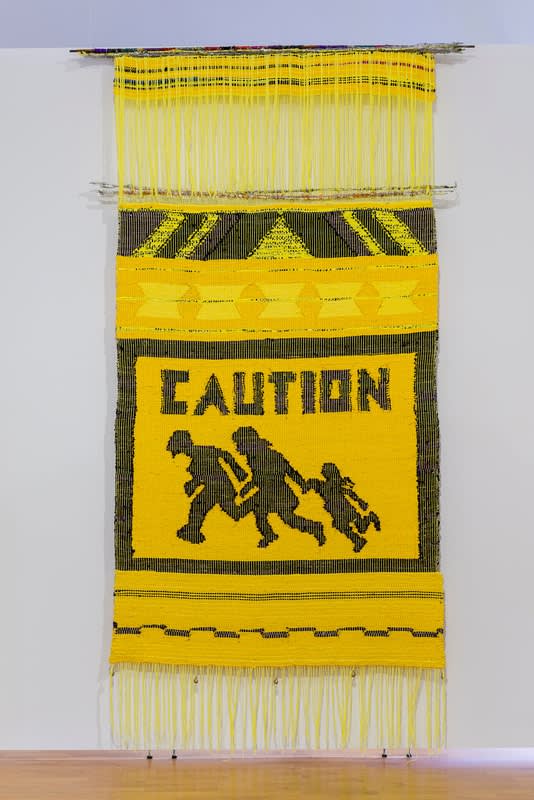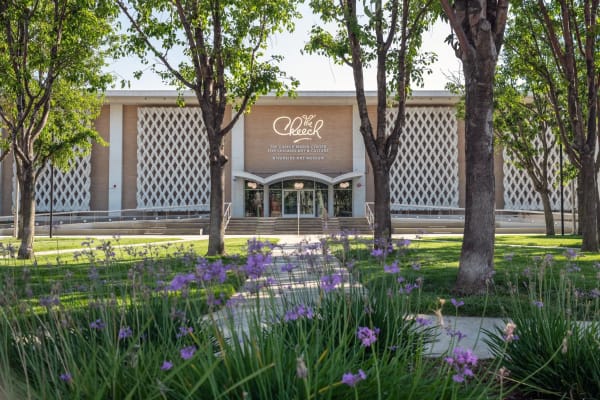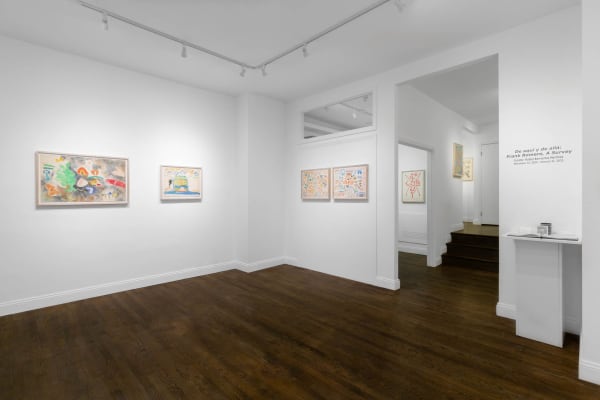Frank Romero USA, b. 1941
A pioneer of the Chicana/o art movement, Frank Romero (b. 1941, Los Angeles) is counted among the earliest and most influential of its participants. Romero’s visual explorations of Chicanidad are cornerstones of this period in art history that arose from El Movimiento, the social and political civil rights movement that began in the early 1970s. Pulling together a diverse cast of signs and symbols to invent a visual language reflective of the multiculturalism that is at the core of the community, Romero uses various mediums, such as paintings, murals, neon, and sculptures, to explore narratives within the Chicano experience, Latin American heritage, and American pop culture, providing insight into his experiences as an artist and a Mexican American in East LA.
Throughout his over 60-year career as an artist, Frank Romero has been a dedicated member of the Los Angeles arts community. As a member of the 1970s Chicano art collective Los Four, Romero and fellow artists Carlos Almaraz, Beto de la Rocha, and Gilbert Lujan helped define and promote Mexican American new awareness through murals, publications, and exhibitions. Los Four's historic 1974 exhibition at the Los Angeles County Museum of Art (LACMA) was the country's first show of Chicano art at a major art institution. This was a landmark for the community, seeing that being Chicano was a revisionist idea. Since then, Romero has successfully balanced a career in public and private arenas. He has completed over 15 murals throughout Los Angeles. He was a key contributor to the 1984 Olympic Arts Festival with Going to the Olympics, a large-scale mural painted in one of Los Angeles’ busiest freeways (Highway 101). Romero now spends six months out of the year at his home in Le Vermont, France, where he still paints every day.
The artist has been featured and reviewed in publications such as The New York Times, LA Times, and Hyperallergic. His work is featured in many permanent collections, including the Smithsonian American Art Museum, Washington, D.C.; Whitney Museum of American Art, New York, NY; Museum of Modern Art Library, New York, NY; The Los Angeles County Museum of Art (LACMA), Los Angeles, CA; National Museum of Art, Washington D.C.; The Carnegie Art Museum, Oxnard, CA; Museum of Contemporary Art San Diego, San Diego, CA; Blanton Museum of Art, Austin, TX; Crocker Art Museum, Sacramento, CA, and the McNay Art Museum, San Antonio, TX.
Romero has exhibited extensively in the United States, Europe, and Japan, with his work being included in notable exhibitions such as Our America: The Latino Presence in American Art, organized by the Smithsonian American Art Museum, Washington, D.C; Chicano Art: Resistance and Affirmation, 1965-1985, organized by the Wight Art Gallery, University of California, Los Angeles, Los Angeles, CA and CARA National Advisory Committee, and Hispanic Art in the United States: Thirty Contemporary Painters and Sculptors, organized by the Museum of Fine Arts Houston, Houston, TX, and the Corcoran Gallery, Washington, DC.
-
 Frank RomeroCaja de sombra - Roswell, Nuevo Mexico, 2024Acrylic on wood13 x 21 x 9 in
Frank RomeroCaja de sombra - Roswell, Nuevo Mexico, 2024Acrylic on wood13 x 21 x 9 in
33 x 53.3 x 22.9 cm -
 Frank RomeroUntitled (Black Drawings), 1971Graphite on paper24.6 x 30.6 in
Frank RomeroUntitled (Black Drawings), 1971Graphite on paper24.6 x 30.6 in
62.5 x 77.7 cm -
 Frank RomeroIndiana Street Mural, Color Cartoon, Across the L.A. River, 1970Gouache on paper17.375 x 22.5 in
Frank RomeroIndiana Street Mural, Color Cartoon, Across the L.A. River, 1970Gouache on paper17.375 x 22.5 in
44.1 x 57.1 cm -
 Frank RomeroUntitled (Black Drawings), 1971Graphite on paper22.625 x 28.625 in
Frank RomeroUntitled (Black Drawings), 1971Graphite on paper22.625 x 28.625 in
57.5 x 72.7 cm -
 Frank RomeroChicano Iconography, 1977Gouache on paper17.625 x 22.75 in
Frank RomeroChicano Iconography, 1977Gouache on paper17.625 x 22.75 in
44.8 x 57.8 cm -
 Frank RomeroChicano Iconography, 1977Gouache on paper17.625 x 22.75 in
Frank RomeroChicano Iconography, 1977Gouache on paper17.625 x 22.75 in
44.8 x 57.8 cm -
 Frank RomeroChicano Iconography, 1977Gouache on paper17.625 x 22.75 in
Frank RomeroChicano Iconography, 1977Gouache on paper17.625 x 22.75 in
44.8 x 57.8 cm -
 Frank RomeroAdobe Series – Tierra café claro, 1995/2024Soil, acrylic, chicken wire on wood24 x 24 x 2.5
Frank RomeroAdobe Series – Tierra café claro, 1995/2024Soil, acrylic, chicken wire on wood24 x 24 x 2.5
60.9 x 60.9 x 6.3 cm -
 Frank RomeroAdobe Series – Tierra blanca, 1995/2024Soil, acrylic, chicken wire on wood24 x 24 x 2.5
Frank RomeroAdobe Series – Tierra blanca, 1995/2024Soil, acrylic, chicken wire on wood24 x 24 x 2.5
60.9 x 60.9 x 6.3 cm -
 Frank RomeroAdobe Series – Tierra roja, 1995/2024Soil, acrylic, chicken wire on wood24 x 24 x 2.5
Frank RomeroAdobe Series – Tierra roja, 1995/2024Soil, acrylic, chicken wire on wood24 x 24 x 2.5
60.9 x 60.9 x 6.3 cm -
 Frank RomeroAdobe Series – Tierra negra, 1995/2024Soil, acrylic, chicken wire on wood24 x 24 x 2.5
Frank RomeroAdobe Series – Tierra negra, 1995/2024Soil, acrylic, chicken wire on wood24 x 24 x 2.5
60.9 x 60.9 x 6.3 cm -
 Frank RomeroPingo and Knife, 1989Silkscreen monoprint (Self-Help Graphics)27.5 x 35.375 in
Frank RomeroPingo and Knife, 1989Silkscreen monoprint (Self-Help Graphics)27.5 x 35.375 in
69.8 x 89.9 cm -
 Frank RomeroAdobe series, Tierra ocre oscuro, 1995/2024Soil, acrylic, chicken wire on wood24 x 24 x 2.5
Frank RomeroAdobe series, Tierra ocre oscuro, 1995/2024Soil, acrylic, chicken wire on wood24 x 24 x 2.5
60.9 x 60.9 x 6.3 cm -
 Frank RomeroLos Four: Almaraz / de la Rocha / Lujan / Romero, 1974Offset lithograph
Frank RomeroLos Four: Almaraz / de la Rocha / Lujan / Romero, 1974Offset lithograph
Artist's Book designed by Frank Romero
Produced at the School of Fine Arts, University of California, Irvine
1500 copies printed by Toyo Printing Los Angeles
Photographs are by Frank Romero and Hal GlicksmanOne continuous 10 x 118" sheet printed recto only -
 Frank RomeroLos Four: Almaraz / de la Rocha / Lujan / Romero, 1974Exhibition poster, Offset lithograph25 x 17.5 in
Frank RomeroLos Four: Almaraz / de la Rocha / Lujan / Romero, 1974Exhibition poster, Offset lithograph25 x 17.5 in
63.5 x 44.5 cm -
 Frank RomeroLos Four en Longo, 1974Exhibition poster, Offset lithograph24.75 x 17.25 in
Frank RomeroLos Four en Longo, 1974Exhibition poster, Offset lithograph24.75 x 17.25 in
62.9 x 43.8 cm -
 Frank RomeroPaginas del Libro, 1980Oil on paper22.125 x 29.75 in
Frank RomeroPaginas del Libro, 1980Oil on paper22.125 x 29.75 in
56.2 x 75.6 cm -
 Frank RomeroNopal, 2024Acrylic, neon on wood29.75 x 17.25 x 8 in
Frank RomeroNopal, 2024Acrylic, neon on wood29.75 x 17.25 x 8 in
75.6 x 43.8 x 20.3 cm -
 Frank RomeroLos Four: Almaraz / de la Rocha / Lujan / Romero, 1974Offset lithograph
Frank RomeroLos Four: Almaraz / de la Rocha / Lujan / Romero, 1974Offset lithograph
Produced at the School of Fine Arts, University of California, Irvine
Artist's book designed by Frank Romero
1500 copies printed by Toyo Printing Los Angeles
Photographs are by Frank Romero and Hal Glicksman25 x 35 in
63.5 x 88.9 cmtotal edition of 1500. Printer's proof -
 Frank RomeroPistola y Calavera, 2023-4Acrylic on canvas36 x 48 in
Frank RomeroPistola y Calavera, 2023-4Acrylic on canvas36 x 48 in
91.4 x 121.9 cm -
 Frank RomeroCowboy, 2024Acrylic on paper24 x 18 in
Frank RomeroCowboy, 2024Acrylic on paper24 x 18 in
61 x 45.7 cm -
 Frank RomeroLa Pistola, 2009Acrylic on canvas8 x 10 in
Frank RomeroLa Pistola, 2009Acrylic on canvas8 x 10 in
20.3 x 25.4 cm -
 Frank RomeroRecuerdo, 1982Oil on canvas70 x 109 in
Frank RomeroRecuerdo, 1982Oil on canvas70 x 109 in
177.8 x 276.9 cm
-

Ruiz-Healy Art now representing Frank Romero
Artdaily, March 21, 2025 -

Ruiz-Healy’s 40-year Frank Romero Survey Traces Early & Ancient Roots of Chicano Art
Nicholas Frank, Glasstire, March 5, 2025 -

De aquí y de allá: A View of Los Angeles in San Antonio | Frank Romero
Christopher Karr, ReVista: Harvard Review of Latin America, January 20, 2025 -

The Year in Latinx Art: Continued Museum and Biennial Support Bolstered by New Market Interest | Frank Romero
Maximilíano Durón, ARTnews, December 31, 2024
-

Must See: “De aquí y de allá: Frank Romero, A Survey” at Ruiz-Healy Art New York
Artforum, December 17, 2024 -

Chicano Artist Frank Romero’s Concurrent Solo Exhibition Criss-Crosses The U.S.
Dr. Ricardo Romo, La Prensa Texas, December 15, 2024 -

De aquí y de allá: Frank Romero, A Survey
14 Nov 2024 — 31 Jan 2025, Ruiz-Healy Art New YorkMeer, December 11, 2024 -

Chicano Artist Frank Romero’s Concurrent Solo Exhibition Criss-Crosses The U.S.
Dr. Ricardo Romo, Latinos in America : Substack, December 11, 2024
-

De aquí y de allá: Frank Romero, A Survey
14 Nov 2024 — 31 Jan 2025, Ruiz-Healy Art New YorkMeer, November 20, 2024 -

De Aquí y de Allá: Frank Romero, A Survey Opens at Ruiz-Healy Art New York
Artdaily, November 14, 2024 -

75 Latinx Artists to Know
Maximilíano Durón, Paula Mejía, Mauricio E. Ramírez, Alex Santana, ARTNews, October 15, 2024 -

Texas in Riverside: Cheech Collects at the Cheech Marin Center for Chicano Art and Culture, Riverside, California | César A. Martínez
Ruben C. Cordova , Glasstire, October 7, 2023
-

‘The Cheech,’ a Game Changer for Chicano Art, Opens in Riverside | César A. Martínez | Frank Romeo | The De La Torre Brothers
Patricia Escárcega, The New York Times, June 12, 2022 -

Arts Preview: Chicano art pioneer Frank Romero is still painting, still loves cars and still defends ugly palm trees
Carolina A. Miranda, Los Angeles Times , March 9, 2017 -

Chicano Art: It’s Time for a New Aesthetic | Frank Romero
Maria Acosta-Colon, Los Angeles Times, September 24, 1990
-

De aquí y de allá: Frank Romero, A Survey
December 5, 2024 - January 25, 2025 San AntonioRuiz-Healy Art is pleased to present De aquí y de allá: Frank Romero, A Survey , a concurrent solo exhibition of works by Los Angeles-based artist Frank Romero, curated by...Read more -

De aquí y de allá: Frank Romero, A Survey
November 14, 2024 - January 31, 2025 New York CityRuiz-Healy Art is pleased to present De aquí y de allá: Frank Romero, A Survey , a concurrent solo exhibition of works by Los Angeles-based artist Frank Romero, curated by...Read more
-
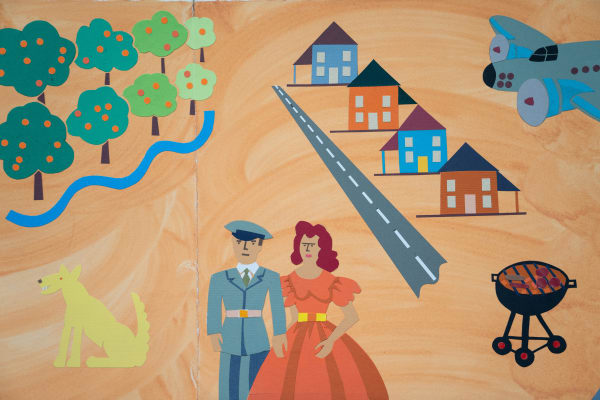
De Aquí y de Allá: Frank Romero, A Survey I Ruiz-Healy Art
Essay by Rafael Barrientos Martínez 2024 Read more -
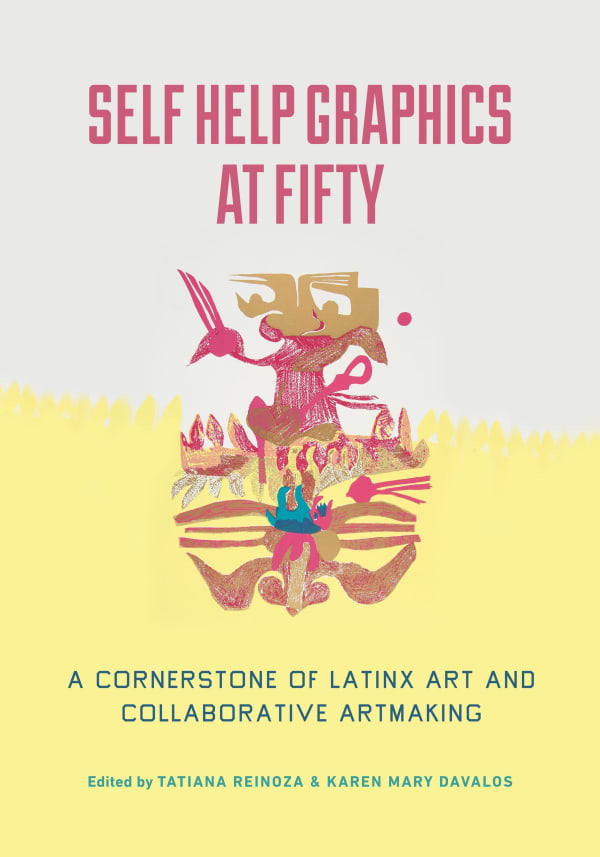
Self Help Graphics at Fifty: A Cornerstone of Latinx Art and Collaborative Artmaking | Frank Romero
Editors: Tatiana Reinoza, Karen Mary Davalos Tatiana Reinoza, Karen Mary Davalos, 2023Paperback, 360 pagesRead more
Publisher: University of California Press
ISBN: 0520390873
Dimensions: 7 x 0.8 x 10 inches -

VOZ : Selections from the UTSA Collection, 2018
Essay by Arturo Infante Almeida 2018Hardcopy, 106 pagesRead more
Publisher: Centro de Artes
ISBN: 978-0-9915043-3-6 -
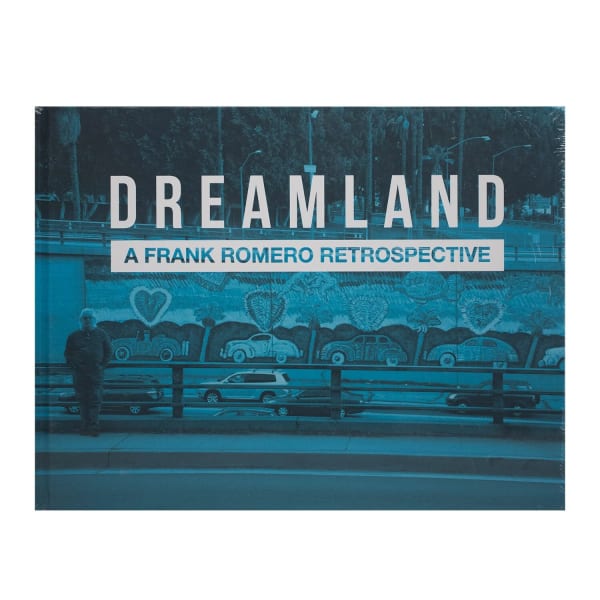
Dreamland: A Frank Romero Retrospective | MoLAA, Los Angeles, CA | Signed Copy
Curator: Edward Hayes | Essay by Patrick H. Ela 2017Paperback, 161 pagesRead more
Publisher: Museum of Latin American Art
ISBN: 0980108098
Dimensions: 12 ¼” W x 9 3/8” L -

Papel Chicano Dos : Works on Paper from the Collection of Cheech Marin | César A. Martínez, Frank Romero
Essays by Cheech Marin and Melissa Richardson Banks Cheech Marin, Melissa Richardson Banks, 2016Hardcover, 96 pagesRead more
Publisher: CauseConnect -
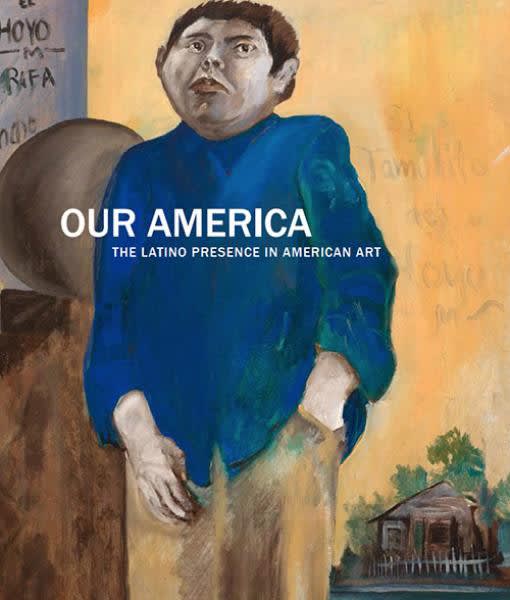
Our America: The Latino Presence in American Art / Smithsonian American Art Museum
Chuck Ramirez, Celia Álvarez Muñoz, Mel Casas, Jesse Amado, Frank Romero Essay by E. Carmen Ramos, and introduction by Tomás Ybarra-Frausto, 2014Hard Cover, 368 pagesRead more
Publisher: Smithsonian American Art Museum
ISBN: 978-0-937311-94-1
Dimensions: 10 x 12" -

Estampas de la Raza: Contemporary Mexican American Prints from the Romo Collection
McNay Art Museum | | César A. Martínez and Richard Armendariz Essays by Lyle W. Williams and Carlos F. Jackson, 2012Hardcover, 152 pagesRead more
Publisher: University of Texas Press
ISBN: 9780916677589
Dimensions: 9 x 0.88 x 11 in -
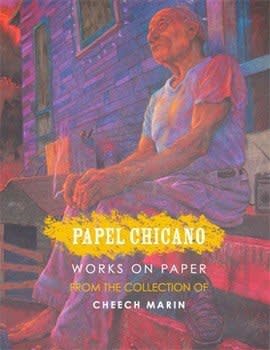
Papel Chicano: Works on Paper from the Collection of Cheech Marin | César A. Martínez, Frank Romero
Essays by Cheech Marin and Melissa Richardson Banks Cheech Marin, Melissa Richardson Banks, 2007Hardcover, 96 pagesRead more
Publisher: La Mano Press -
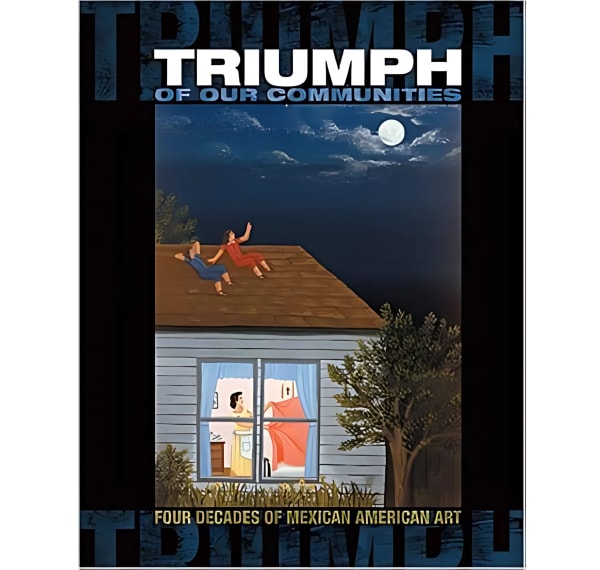
Triumph Of Our Communities: Four Decades Of Mexican American Art by Gary Keller and Amy Phillips
César A. Martínez and Frank Romero 2005Hardcover, 314 pages pagesRead more
Publisher: Bilingual Press
Dimensions: 11.25 x 1.5 x 14.25 inches -

Chicano Art for Our Millennium: Collected Works from the Arizona State University Community | | César A. Martínez, Frank Romero
Authors; Mary Erickson, Pat Villeneuve, Gary D. Keller 2004Paperback, 199 pages pagesRead more
Publisher: Bilingual Pr
Dimensions: 8.75 x 0.5 x 11.75 inches -
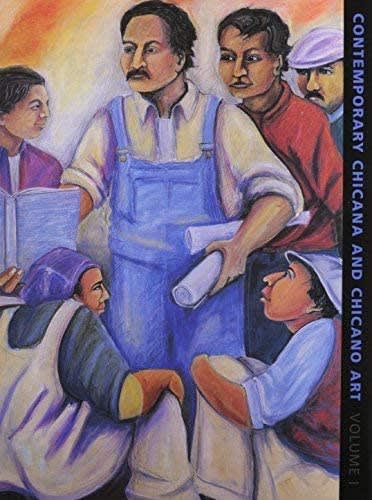
Contemporary Chicana and Chicano Art: Artists, Works, Culture, and Education
Featuring: Celia Álvarez Muñoz, Consuelo Jimenez Underwood, César A. Martínez and Frank Romero Gary D. Keller, Mary Erickson, Kaytie Johnson, Joaquín Alvarado, 2003 Read more -

Chicano Visions : American Painters on the Verge | César A. Martínez, Frank Romero
Essay by Cheech Marin Cheech Marin, 2002Paperback, 160 pagesRead more
Publisher: Little Brown & Co -

Arte Latino: Treasures from the Smithsonian American Art Museum
Author: Jonathan Yorba I Featuring: Frank Romero and Mel Casas 2001Paperback, 112 pages pagesRead more
Publisher: Watson-Guptill Publications
Dimensions: 9.16 x 9.24 x 0.46 inches -

East of the River: Chicano Art Collectors Anonymous | Frank Romero
Editor: Chon A. Noriega Santa Monica Museum of Art, 2001Paperback, 80 pagesRead more
Publisher: Santa Monica Museum of Art
ISBN: 0962494100
Dimensions: 9.25 x 0.25 x 9 inches -
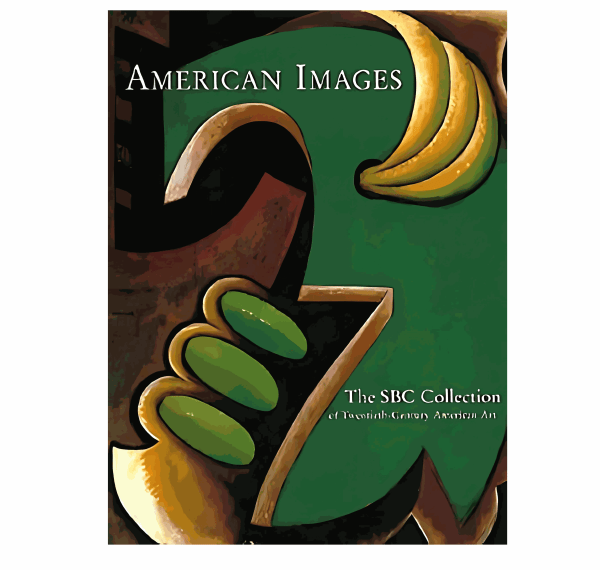
American Images: The SBC Collection of Twentieth-Century American Art
Featuring: Jesse Amado, César A. Martínez and Frank Romero Authors: Betsy Fahlman, Matthew Baigell, Susan C. Larsen, et al. , 1996Hardcover, 320 pages pagesRead more
Publisher: Harry N Abrams Inc
Dimensions: 9.75 x 1.5 x 11.75 inches -
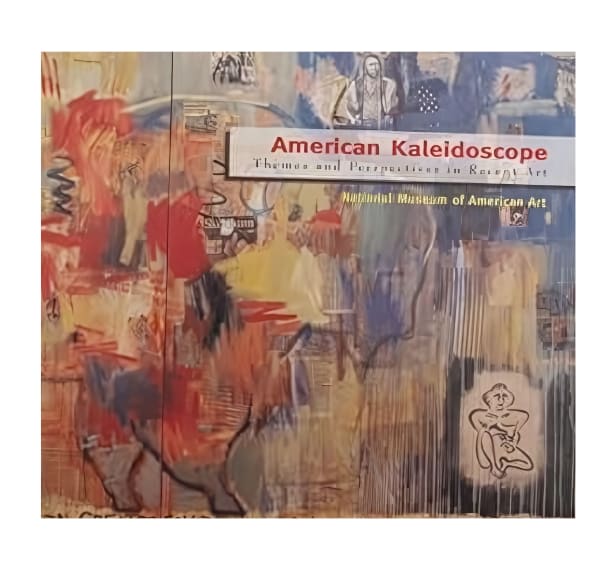
American Kaleidoscope: Themes and Perspectives in Recent Art. National Museum of American Art, Smithsonian
Featuring Frank Romero I Author: Jacquelyn Days Serwer 1996Softcover, 160 pagesRead more
Publisher: Distributed Art Pub Inc
Dimensions: 9.75 x 0.5 x 11.25 inches -

Chicano Art: Resistance and Affirmation, 1965-1985
Celia Alvarez Muñoz, Mel Casas, César A. Martínez, Frank Romero Richard Griswold Del Castillo, Teresa McKenna & Yvonne Yarbro-Bejarano, editors, 1991Softcover, 373 pagesRead more
Publisher: Wight Art Gallery, University of California, Los Angeles
ISBN: 0943739152
Dimensions: 9.25 x 1.25 x 12.5 in -
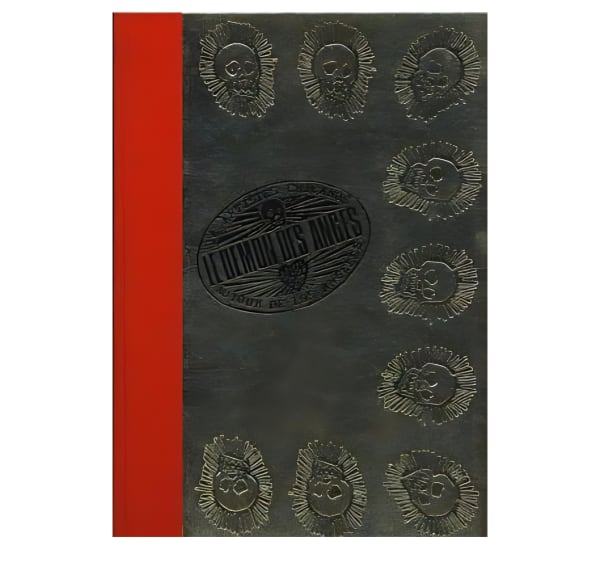
Le Demon Des Anges: 16 Artistes Chicanos autour de Los Angeles | Frank Romero
Author: Pascal Letellier 1989Hardcover, 245 pagesRead more
Publisher: Centre de recherche pour le développement culturel, Nantes, France; Generalitat de Catalunya, Barcelona, Spain.
ISBN: 0000000654814 -

Hispanic Art in the United States | César A. Martínez & Frank Romero
John Beardsley and Jane Livingston, with an essay by Octavio Paz John Beardsley and Jane Livingston, with an essay by Octavio Paz, 1987 Read more -

Chicano Expressions New View in American Art | INTAR Latin American Gallery | César A. Martínez & Frank Romero
Essays by Inverna Lockpez, Tomas Ybarra Fausto, Judith Baca, and Kay Turner 1986Paperback, 48 pagesRead more
Publisher: INTAR Latin American Gallery -

Ancient Roots / New Visions | Tucson Museum of Art
Featuring: César A. Martínez and Frank Romero Essays by Marc Zuver and Rebecca Kelley Crumlish , 1977 Read more -

Los Four: Almaraz/de La Rocha/Lujan/Romero
Los Angeles County Museum of Art, Los Angeles, CA 1974 Read more


